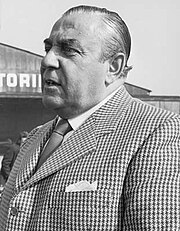Carlo Abarth
Karl (Carlo) Abarth (November 15, 1908 - October 24, 1979) was an Italian-Austrian automobile designer.
Abarth was born in Vienna, Austrian Empire. As a teenager, he worked for Castagna in Italy (1925-27), designing motorbike and bicycle chassises. Back in Austria, he worked for Motor Thun and Joseph Opawsky (1927-34), and raced motorbikes, winning his first race in a James cycle in Salzburg on July 29, 1928). He later was European champion five times, along continuing the engineering. After a serious accident in Linz he abandoned motorbike racing, and designed a sidecar (1933) with which he managed to beat the Orient Express railway on the 1300 kilometer stretch Wien-Oostende (1934).
He moved permanently to Italy (1934) where he got to know Ferdinand Porsche's son-in-law Anton Piëch, and married his secretary. Abarth was long hospitalized and had his racing career ended, due to a racing accident in Jugoslavia (1938). Following this, he moved to Merano, where his family originated. Abarth got to know both Tazio Nuvolari and the family-friend Ferry Porsche, and with engineer Rudolf Hruska and Piero Dusio, he established the «Compagnia Industriale Sportiva Italia» (CIS Italia, later becoming Cisitalia), having the Italian Porsche Konstruktionen agency (1943-48). The first automobile outcome of this cooperation was the rather unsuccessful «Tipo 360» F1 prototype (see also Porsche 360). The «CIS Italia» project ended when Dusio moved to Argentina (1949).
Carlo Abarth then founded the Abarth & C. company with Armando Scagliarini (father of Cisitalia racing driver Guido Scagliarini) in Torino (March 31 1949), using his Scorpio as the company logo. The company made racing cars, and became a major supplier of high-performance exhaust pipes, that still are in production as «Abarth». Carlo Abarth personally set various speed records on the Autodromo Nazionale Monza (October 20, 1965). He sold the company on July 31 1971 to FIAT.
